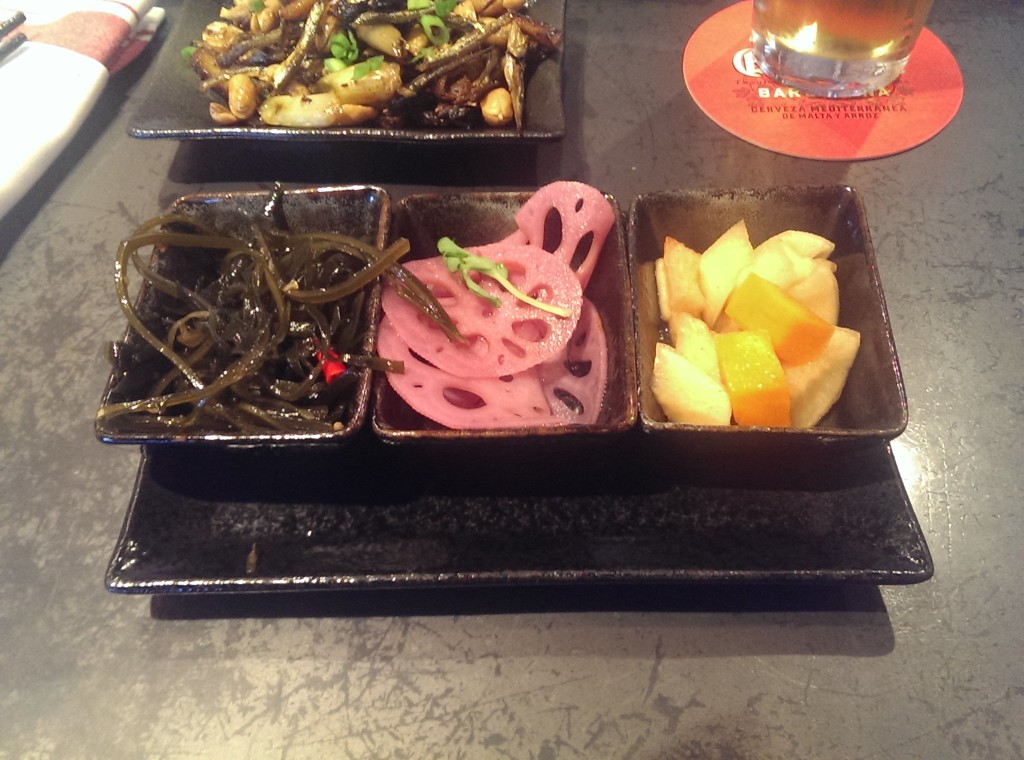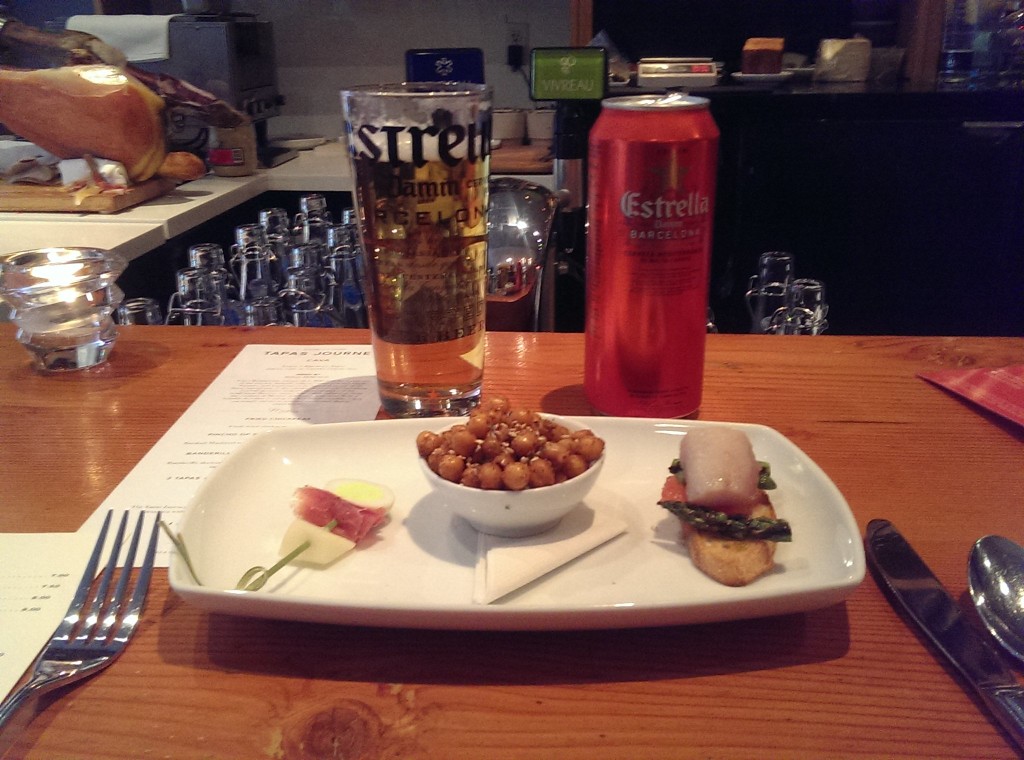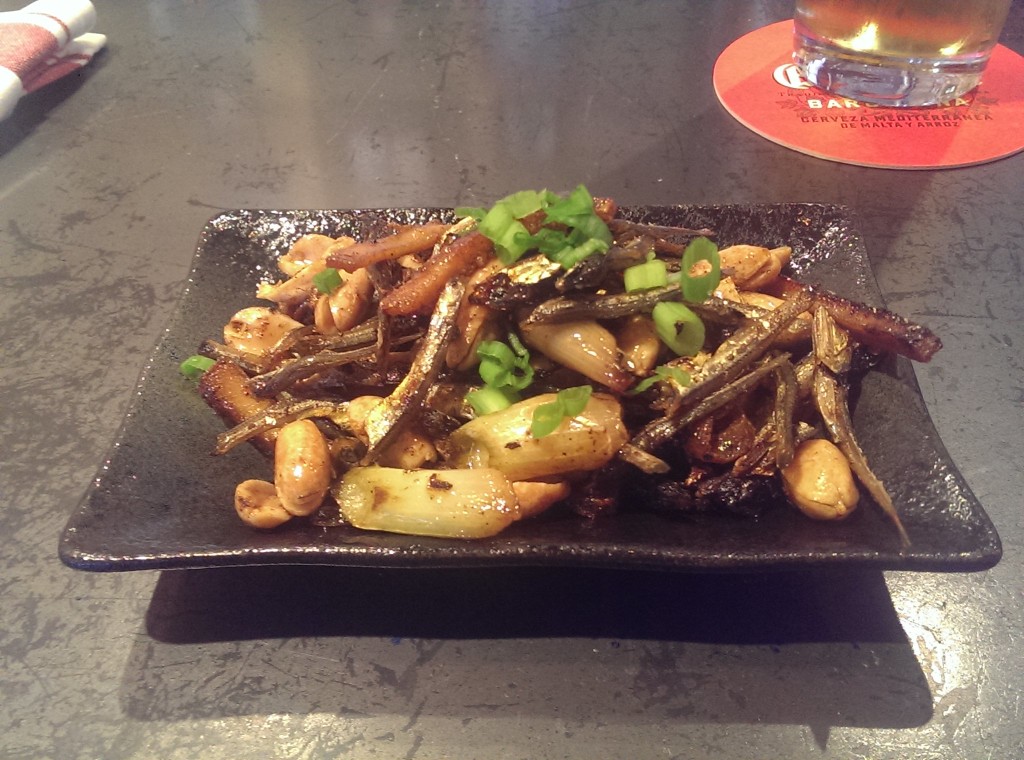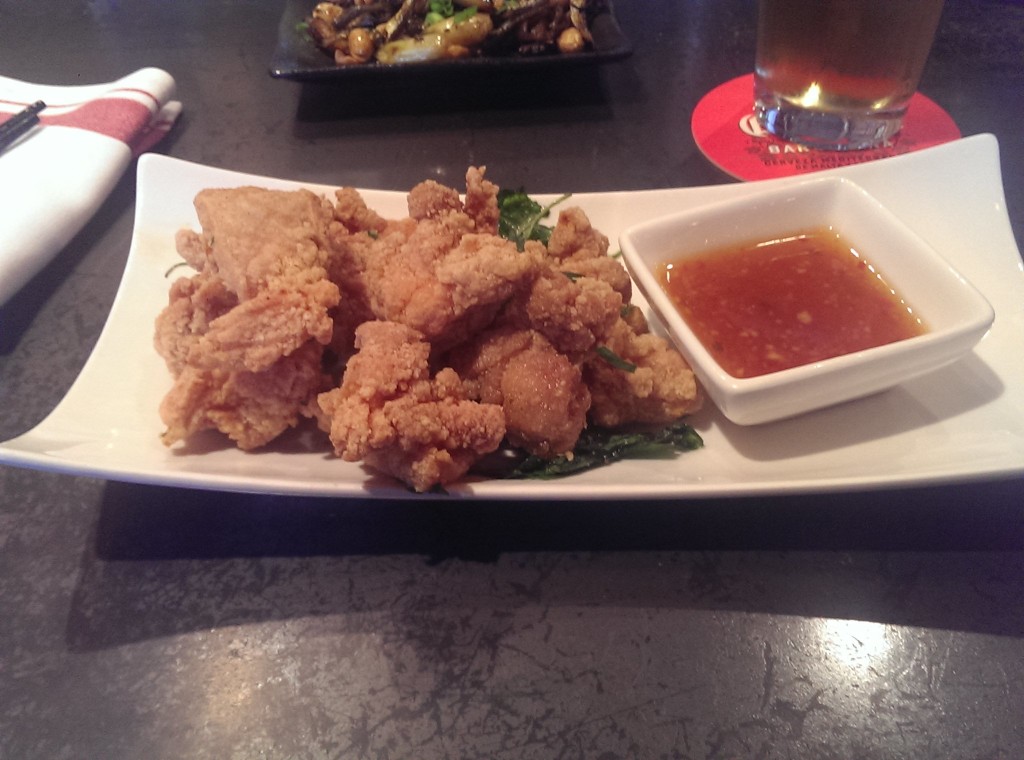There’s always something a little dispiriting about a delivery you’re not expecting showing up at the apartment when you’re out of town. All you can really do is buzz the guy into the building with instructions to leave it in front of your door and hope that the neighbours don’t have a larcenous streak. My neighbours have been uniformly excellent for the last decade. The only time a delivery has ever gone missing, I got a knock on the door and an apologetic “I think they delivered this to the wrong apartment.” We don’t even jaywalk in midtown.
I had forgotten about the phone call entirely until Sunday evening, but there sat the unmolested package, its contents unknown. It turned out to be part of a promotion for Estrella Damm focusing on Tapas and containing gift certificates to go and eat food. I like delicious, punchy food and there is apparently a contest on to go and see Ferran Adria. I have read the El Bulli cookbook, so I can get behind that. The problem that I have is with Estrella Damm itself.
The Spanish have not traditionally been thought of as much of a beer culture. Marvelous wines. Tart, refreshing sidra. I’m given to understand from flashes of social media that there is craft beer in Spain (just like everywhere else) and that the scene is expanding with some rapidity. Long before that, Spain got what everyone else got: expatriate German brewers.
It happened in the USA and Canada and Thailand and Japan and Mexico. It happened everywhere. Around the period of German unification under Bismarck and the wars and general strife such a political consolidation yields, Germans left border regions like Alsace, Swabia and the Palatinate. I have talked about this before and about the eventual ramifications on what we think of as beer food in North American which is basically a modified Oktoberfest diet.
In places where you got brewers independent of a large population of settlers, you got more or less the beer that was popular in Germany at the time. The trend had been lightening lager styles edging towards the Helles: Less hopping, less body, lighter colour. If you ever wondered why mass produced lager was so popular worldwide, that’s the reason.
Estrella Damm is from about 1876 and was the result of August Damm moving from Alsace to Barcelona. It’s even lighter than the styles in Germany from that era and included barley and rice at its inception. It now contains barley, rice and corn. If you pay close attention to the aroma, you can pick out both the steamed rice and corn grits far more quickly than you can detect any specific hop character. To a modern craft beer audience, Estrella Damm is more or less anathema.
David Chang wrote a piece a while back championing beers like this. Garrett Oliver wrote a follow up piece which amounted to a disbelieving “Really?” and we all had a couple of days of angsty navel gazing while wondering whether Mr. Lucky Peach might have been right. I’m suspicious when a cook tells you he prefers a thin watery gruel of barley, rice and corn over something a touch more piquant. You’re told frequently if you follow beer media that there are three kinds of beer and food pairing: Cut, Contrast and Compliment. There’s a fourth and it comes largely under the heading of “get the hell out of the way.”
When it comes to cuisines from countries that didn’t grow up alongside beer, it’s no wonder they prefer something that gets out of the way. The important thing is not really that the beer matches the food. The important thing is that the beer is cold and washes the food down.
Take a look at this plate of tapas from Cava in Toronto. Cava is at Yonge and St. Clair and they’ve been doing high quality Spanish and Andorran tapas since 2006, long before the current wave of Bourdain inspired interest.
On the left you have a skewer with a creamy room temperature manchego, a ribbon of jamon trevelez and a quail egg pickled in a rice wine vinegar escabeche. In the centre, you have fried chickpeas with a zatar comprised of sesame seeds, salt, sumac, oregano and marjoram. On the right, a crostini with smoked mackerel, grilled asparagus and small segments of pink grapefruit.
These things are designed as bites and they are more or less self-contained. The slight acidity from the pickled egg contrasts the creaminess from the manchego and is brightened up by the salt and light smoke from the jamon. A more assertive lager like a pilsner might be on more equal footing than Estrella Damm, but if the idea is to showcase the food you want something that won’t leave any impression at all. “Vaya!” says the jamon. “Get out of the way.”
I wondered whether it might not be a good idea to try one of the other locations on the tour that was not cadging from the Spanish pantry. Valdez looked like a good option with its Latin American inspired street food, but it wasn’t really far enough away.
I settled on Kanpai Snack Bar in Cabbagetown at Carlton and Parliament, since I really don’t know about Taiwanese food and I figured it’d be a good test of the theory. I’m also pleased to report that Kanpai is quite good value for money and that the hip hop naming conventions of the menu are a lot of fun. As I understand it, Taiwan’s food exists as a sort of crossroads of various Asian influences. Will a Spanish beer work?
The Kanpai tapas menu consists of MC Hammer, a sort of spicy popcorn chicken in a karaage style differentiated by what I think was Szechuan peppercorn in the breading. There’s Taiwanese Antipasto consisting of pickled carrot, lotus root and seaweed given a sort of japchae treatment. Finally, Funny Fish, a bar snack of fried mini fish and tofu with peanuts and chilis.

I really enjoyed the lotus root, which seemed to have taken on a little numbing heat from some szechuan peppercorns. I should have asked, I suppose.
This is an excellent metric for the “Get out of the way” school of thought. Everything goes with delicious fried chicken and the stinging zazz of the breading really only demands cold and wet. The salt and acidity of the antipasto enforce similar criteria. The Funny Fish are vaguely reminiscent in flavour profile of Lao Gan Ma because of the peanut and chili oil and between the funk of the tiny fried fish and the friability of their little skulls between your teeth, it’s hard to know what could possibly stand up to that in a conventional sense.
I wouldn’t choose to drink Estrella Damm by itself. While it’s well made, I find it pretty boring. I doubt that I could pick it out of a lineup in a blind taste test with other breweries founded in similar circumstances. That said, I can certainly see why it would be popular in Spain with small punchy dishes that demand of it only that it be cold and wet and contain alcohol.



I’ve visited several of the tapas towns in Spain to get the real thing: a small plate with something to eat to comes free of charge with every drink you order. (And I stress the free-of-charge thing. If I have to pay extra, I won’t consider it a Tapa, a Ración, perhaps, but a true Tapa–be it in the form of a Pintxo or not, is not something you have to pay on top). Since the food was almost invariably very good, and the beer, very cold and bland, I convinced myself that it was the food what I was paying for, and the beer what was complimentary. I ended up enjoying the beer a lot more.